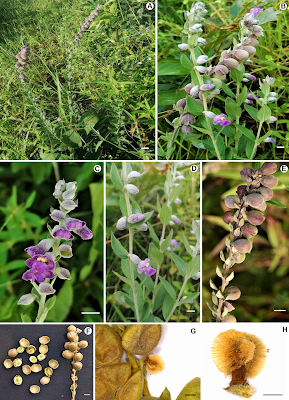 |
| Tinnea gombea Zhigila, in Zhigila, Aigbokhan & Muasya, 2023. Photos by D.A. Zhigila. |
Abstract
Tinnea gombea, endemic to the Sudan savanna grasslands in northern Nigeria, is described and illustrated. We used integrative evidence from morphological characters, ecology and molecular phylogenetic data. The new species is morphologically and ecologically similar to T. barteri and T. aethiopica, but can be readily delimited from these taxa by unique characters including a subshrub growth habit, leaves alternate to subopposite, blades lanceolate, apically acuminate, inflorescences raceme, bearing solitary flowers in upper leaf and bract axils, lilac to purplish dusky flowers and the inflated fruits dehiscent. The distribution and habitat of T. gombea are also distinctive, being restricted to the Sudan savanna, while the two most similar species are widespread in tropical Africa. Additionally, molecular phylogenetic assessments using nrITS and chloroplast trnL-F, matK and rbcL support the placement of T. gombea as a distinct species. Tinnea gombea is here assessed as Critically Endangered due to its small population size and restriction to a small area lacking conservation prioritization.
Tinnea gombea Zhigila sp. nov.
Diagnosis: Tinnea gombea is most similar to T. barteri in branches being lax (2–5 in number), stems terete in cross-section, leaf blades minutely hairy on both sides, inflorescence racemose, calyx bladder-like and in ecological requirements; but differ in growth form being annual subshrub, to about 40 cm tall, branching pattern fastigiate (versus annual herb, >50 cm tall, virgate in T. barteri), leaf attachment alternate to 2-nate or subopposite, blade lanceolate, leaf apex acuminate in T. gombea (versus opposite, orbicular, mucronate in T. barteri), inflorescence racemose, solitary flowers in leaf and bract axils, anthers with basal hairs (versus spikes to 2–3-cymes, on long terminal head, anthers glabrous in T. barteri) and fruits dehiscent (versus indehiscent in T. barteri) (Table 3).
Etymology: Tinnea gombea is named after its type locality, Gombe State, Nigeria.
Distribution and habitat: Tinnea gombea is endemic to the Sudanian savanna and is currently known from Gombe State (Fig 3). Apparently, the species is uncommon within its area of occurrence in grasslands and woodlands of Sudanian savanna. Usually found on abandoned farmland together with various annual herbs and with perennial shrubs such as Spermacoce L. species, Oldenlandia corymbosa L., Eragrostis tremula Hochst., Physalis angulata L. and Vernonia ambigua Kotschy & Peyr. It usually grows at an elevation of about 620 m above sea level.
Daniel A. Zhigila, Emmanuel I. Aigbokhan and A. Muthama Muasya. 2023. Tinnea gombea (Lamiaceae), A New Species from the Sudanian Savanna Region, Nigeria based on Integrative Evidence. PLoS ONE. 18(3): e0280550. DOI: 10.1371/journal.pone.0280550
